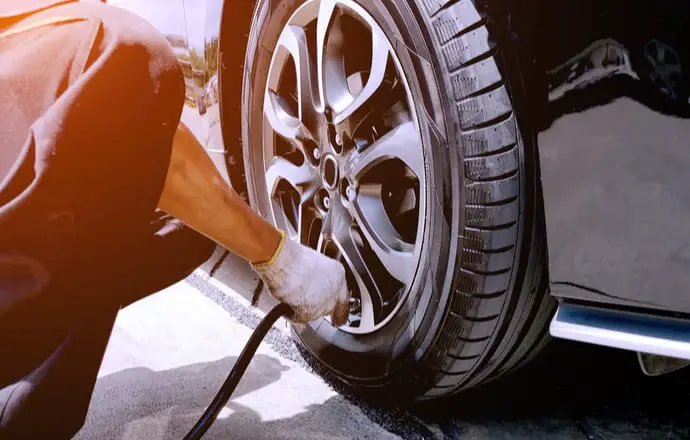Last Updated on September 28, 2022 by

Tyre damage can occur at any point when out and about driving, with a puncture forcing you to take action and act immediately. You have 3 options if your tyre incurs a puncture or hole when driving – call someone to tow you away, replace the tyre yourself if you have a spare in the back, or use some temporary tyre sealant to keep you on the road until you get it sorted. Tyre sealant is a temporary solution usually in the form of a gel or liquid that will seal up any punctures or holes in the tyre and avoid any further damage.
It works by taking off the tyre valve cap and attaching your sealant bottle to the tyre valve and squeezing the solution in, then applying compressed air to ensure the tyre is strong enough and at the right pressure. Some bottles of this temporary patch-up slime or solution come with an air hose included, so you can apply your sealant and inflate your tyre all in a winner. We have 5 top sealants for car tyres listed below, each with different sealing properties, accessories and application methods to prevent and temporarily resolve puncture issues.
Best Car Tyre Sealants in the UK Reviews
|
Image |
Sealant |
Volume |
Price |
|---|---|---|---|
 |
Top Pick |
450 ml |
|
 |
400 ml |
||
|
|
473 ml |
||
 |
473 ml |
||
 |
1 L |

This is the current industry standard for car tyre sealant. It is the same product that often comes with new cars of a vast array of brands including Ford, Volkswagen, Audi, Honda, Volvo and more. Even though it is used by many different car manufacturers, it is not used by all of them.
That said, it is completely independent of the make and model of the car, it can universally be used on any car tyre no matter the make or model and should perform just as well. It can support wheels that have up to a 21-inch rim and seals punctures up to 6 millimetres.
AirMan uses its own proprietary Active Seal Particle Gel Sealant formula and the gel is applied through an air compressor directly into the car tyre. The gel’s particles are fine enough that you do not need to remove the valve core before using. It is as simple as connecting the sealant to the tyre with the supplied hose and then starting the compressor.
The sealant isn’t toxic or corrosive and washes away with water, so there shouldn’t be any issues of it damaging your tyres or rim further and it should be a simple process of rinsing the tyre with water to remove the gel from the tyre when it undergoes repairs. Due to its biodegradable nature, you don’t have to worry about the gel negatively impacting your environment when it is washed out.
Pros
- Completely universal and works on all makes and models of cars
- Non-toxic, non-corrosive, biodegradable particle gel sealant
- Extremely easy and convenient to use
Cons
- Expensive compared to other options

This is another option for tyre repair but this time from Holts. This option does not require any extra parts and can be used quickly whenever you need it. This is a cheaper alternative when compared to the previous entry and it is compatible with any tubeless tyre. It is small and compact which makes for easy storage.
Much like the previous option this still works by connecting the canister to the tyre valve and then twisting the top of the canister to start the process. It takes approximately two minutes for the canister to empty into the tyre after which you should drive for about 6 miles to ensure that the tyre is properly sealed.
The National Tyre Distribution Association approves of Holts Tyreweld for emergency tyre repairs. If you need a cheap and quick fix to a leaking tyre in a dire situation then you’ll definitely want to have Holts Tyreweld available.
Pros
- National Tyre Distribution Association approved tyre repair solution
- Very inexpensive and small for easy storage
- Simple and quick to use in an emergency
Cons
- Comes with the least amount of tyre solution and is more limited by tyre size than other options

Slime is a tyre sealant that works on both tubular and tubeless tyres though it is less effective on a tubular tyre. It can seal punctures of 3 millimetres or less on a tubular tyre, but it can seal up to 6-millimetre punctures for tubeless tyres. It is not flammable at all and can be used with CO2 without freezing so it is very resistant to temperature and lasts as a repair option for a long time.
The gel is non-corrosive and non-toxic so there shouldn’t be any extra damage to your tyres caused by this material and there is no need to fear it causing damage to you or the environment if you come into contact with it during use, simply rinse it off and there shouldn’t be any issues.
Apply the slime through the tyre valve, remove any excess from the outside, then drive your vehicle for a few miles to ensure the slime sets. Afterwards, you will have to re-inflate your tyre and then you will be ready to continue on your way.
Pros
- Not toxic or corrosive so it is safe to use and won’t damage your equipment or skin
- Relatively cheap and simple to use
- Works on both tubular and tubeless tyres without issue
Cons
- Less effective on tubular tyres than tubeless tyres

Stan’s tyre sealant is made specifically for tubeless tyres and is not recommended for use with tubular tyres. This tyre sealant is made specifically for bicycle tyres but should be effective for car and motorcycle tyres without issue.
Unlike previous options, you don’t have to use the entire quantity of sealant for a single tyre, you can use it on 10 – 20 tyres which makes it an excellent purchase if you are going to be travelling a long distance and are worried about flat tyres on your vehicle.
The only concern when using this sealant is to ensure that your wheels are tight to the rim of the vehicle so that there is no leakage when you re-inflate the tyre after application. After use, ensure that the container is sealed tightly so the sealant remains effective in the future.
Pros
- Very cheap considering how many uses you get out of it
- Extremely versatile, is effective on tyres for several different types of vehicles
- Can be used multiple times, not all of the sealant is required for a single puncture
Cons
- Only works on tubeless tyres

GOOP is meant to be a preventative measure to be used before a tyre puncture occurs. You apply the sealant after purchasing and it is meant to protect against punctures for the entyre life of the tyre. It can be used in both tubular tyres and tubeless tyres with equal effectiveness and a valve tool is already installed in the cap so no other equipment should be required.
It is both effective at sealing punctures and preventing leaky rims. Once it is time to replace the tyre you can simply wash away the goop material with water and it shouldn’t leave any residue behind or damage the wheel at all. It is stable even when heated to a high temperature and also cannot be frozen so there shouldn’t be any issues with it no matter what time of year it is.
Pros
- Effective at any temperature
- Can be used on any kind of tyre
- Is useful for preventing punctures and also for leaky rims
Cons
- Often prevents tyre repairs
Sealant for Car Tyres Buying Considerations
Tyre Repair
It is often not recommended to use tyre sealant solution because it has an effect on the inside of a tyre that makes it difficult to repair and many garages won’t operate on it once they know you have used tyre sealant. You should know that if you must use a tyre repair solution in a dire circumstance, you will likely end up having to replace the tyre instead of getting it repaired which will cost more.
A Quick-Fix or To Prevent Damage?
Some sealants are specifically intended to be used to fix a tyre that is already punctured, but some are meant to be used before a puncture occurs and will fix a puncture that occurs afterwards. It is important to read the container and find out what kind of sealant you are about to buy. It wouldn’t be very efficient to buy a preventative sealant for a tyre that is already punctured and you don’t want to use a quick-fix as a preventative measure.
In Conclusion
A tyre sealant is a backup if you don’t have a spare tyre or have the confidence to change it on the spot when a puncture or hole appears. This gel, liquid, slime or whatever solution you choose isn’t a permanent solution for fixing punctures in your tyre and will require you either replace or fix the tyre for safe driving in the future. These sealants not only temporarily fix punctures or holes, but can also be used preemptively to protect the tyre from future damage if that’s a concern to you when driving. Our best car tyre sealant pick overall is the AirMan 65-005-001 ATVT as it has an attached air hose with a good quality protective sealant at a fair price.
